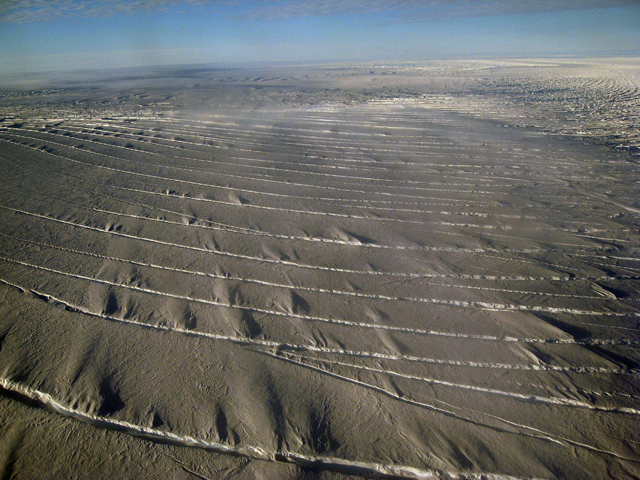Model problemScientists cautious about ability to predict sea-level rise from WAISPosted July 10, 2009
David Holland “It’s not clear yet that it’s predictable,” said Holland, a co-principal investigator on a project More on PIG
The United Nations Intergovernmental Panel on Climate Change (IPCC) In particular, Pine Island Glacier (PIG) and nearby Thwaites Glacier are speeding up, with the capacity to drain a third of the West Antarctic Ice Sheet. Another third flows into the Ronne Ice Shelf, with roughly another third draining into the largest of all ice shelves, the Texas-sized Ross Ice Shelf. “[Pine Island] is the third that I think everybody is worried about. There isn’t a big ice shelf holding it back,” noted Robert Bindschadler “This will be the first site of major Antarctic ice sheet loss,” added Bindschadler, a veteran polar scientist at NASA’s Goddard Space Flight Center Many experts have said they expect the oceans to rise at least a meter by 2100, though not uniformly around the world, with some predicting heavy flooding along the east coast of the United States and Canada as ocean currents change. In another recent scenario posited by scientists, the change in mass in the southern hemisphere as the West Antarctic Ice Sheet melted would drive more water toward North America as gravity strengthened in the northern hemisphere. Director of the Center for Atmosphere Ocean Science at New York University What’s the circulation doing? How often does the warm water intrude on the shelf? What are the melt rates? Those are the sorts of questions the scientists hope to answer with a small array of ocean profilers developed by Tim Stanton’s team in the Oceanography Department at the Naval Postgraduate School “There are great implications for sea-level rise. We really do have to understand this problem,” Stanton said. “It’s pretty intriguing that this group with different interests has been brought together to address this really knotty problem.” What polar researchers suspect is that increased intensity in westerly winds around Antarctica is helping draw that deep ocean water onto the continental shelf in Pine Island Bay. Other scientists farther north along the Antarctic Peninsula have observed a similar phenomenon as part of the Palmer Long Term Ecological Research A number of scientists believe the disruption of ozone in the stratosphere may be responsible for the change in circulation lower in the atmosphere over Antarctica. In theory, the predicted recovery of the ozone layer later this century could ease the westerly winds and their effect on ocean circulation. Holland is also cautious on that account. “The atmosphere is a very chaotic, delicate beast, so whether or not that is predictable is a question,” he said. Bindschadler is optimistic that the upcoming expedition will fill in important gaps of knowledge about ocean and ice interaction. “What we can say confidently is that we know so little about this environment that we’re sure to discover something. That’s the exciting thing. We know we’re going to discover something about a very important process about how climate is changing on Earth, right now and affecting this generation and the next generation and the next generation,” he said. “This is science in the here and now,” he added. “This stuff really matters to … people who are living on this planet and to the nearly half of the world’s population that are living close to the coast — this matters. … It’s probably the most immediately relevant science I’ve done in my career.” |



For USAP Participants |
For The Public |
For Researchers and EducatorsContact UsNational Science FoundationOffice of Polar Programs Geosciences Directorate 2415 Eisenhower Avenue, Suite W7100 Alexandria, VA 22314 Sign up for the NSF Office of Polar Programs newsletter and events. Feedback Form |



